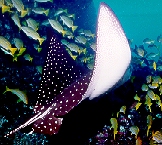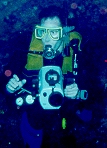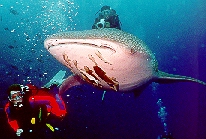
 It's difficult to escape too far from
civilisation nowadays, and this is especially true if you
can only spare a couple of weeks away, but I decided to
leave the beaten track as far as possible by choosing a
destination that is pretty remote. Isla de Cocos lies 350
miles off of Costa Rica’s Pacific coast - it seemed
to fit the bill.
It's difficult to escape too far from
civilisation nowadays, and this is especially true if you
can only spare a couple of weeks away, but I decided to
leave the beaten track as far as possible by choosing a
destination that is pretty remote. Isla de Cocos lies 350
miles off of Costa Rica’s Pacific coast - it seemed
to fit the bill.A friend of mine, Christina Campbell, who has done a lot of pretty serious diving came back from Cocos a few years ago and raved about it, so I called my trusty Agent, Jan, at Sure Dive who efficiently tailored an itinerary for me.
The trip out was hairy, but I survived the worst that United had to throw at me - like reassigning my row as smoking after a stopover in Mexico City. A scant 48 hours after leaving London I climbed aboard the Okeanos Aggressor at Punta Arenas.
The cruise out to Cocos is a long, and often rough one. But 36 hours later we woke to the sight of towering cliffs, and tumbling waterfalls. Cocos has a colourful history - it was an old Pirates' haunt, and reputedly still hides millions in gold bullion, but a single glance at the terrain tells you why little of this wealth has been recovered.
If you ever get the chance, and fancy a day off from diving, the hike up to the summit is an easy five hours, and is very rewarding- and there are no mosquitoes!
 Cocos's beauty is literally in it's isolation -
visitors run only into the hundreds annually, with no
permanent settlement . It is because it is so isolated
Cocos has escaped a lot of pressure from the fishing
industry - as well as attracting lots of pelagics who
come to breed, or maybe just to hang out. The island was
declared a national park by the Costa Rican government in
1978 but ecological pressures in the form of illegal
fishing mount. I hope it is allowed to remain a jewel in
the Pacific.
Cocos's beauty is literally in it's isolation -
visitors run only into the hundreds annually, with no
permanent settlement . It is because it is so isolated
Cocos has escaped a lot of pressure from the fishing
industry - as well as attracting lots of pelagics who
come to breed, or maybe just to hang out. The island was
declared a national park by the Costa Rican government in
1978 but ecological pressures in the form of illegal
fishing mount. I hope it is allowed to remain a jewel in
the Pacific.
We acclimatised ourselves to our new surroundings, and shook out our kit. The next seven days saw some superlative diving - I understand why the people in the know rate this as one of the best dive sites in the world.
 We were promised a shark on every dive - heard
that one before? Well, Mario, the dive master, wasn't
exactly out on a limb on that one- they were everywhere.
Schools of hammerheads coming in to cleaning stations,
squadrons of manta, marble and eagle rays, white-tip reef
sharks carpeting the rock, even inquisitive turtles that
paused to say hello. And occasionally, as you hung in
blue water, a silky coming in to check you out.
We were promised a shark on every dive - heard
that one before? Well, Mario, the dive master, wasn't
exactly out on a limb on that one- they were everywhere.
Schools of hammerheads coming in to cleaning stations,
squadrons of manta, marble and eagle rays, white-tip reef
sharks carpeting the rock, even inquisitive turtles that
paused to say hello. And occasionally, as you hung in
blue water, a silky coming in to check you out.
 Cocos doesn't have a fringing reef as such -
just a few patches of staghorn here and there - in the
main the bottom is sandy or rocky - ideal for anchoring
photographers provided you avoid the copious population
of urchins. I've never so much as touched a camera
underwater, but I quickly adopted one of the boat's Sony
Hi-8s, a really easy alternative even in my amateurish
hands - and allowing replays minutes after each dive -
"There - look - it was a Silky circling behind you,
Mark". And then I decided to give a Nikonos a try.
Cocos doesn't have a fringing reef as such -
just a few patches of staghorn here and there - in the
main the bottom is sandy or rocky - ideal for anchoring
photographers provided you avoid the copious population
of urchins. I've never so much as touched a camera
underwater, but I quickly adopted one of the boat's Sony
Hi-8s, a really easy alternative even in my amateurish
hands - and allowing replays minutes after each dive -
"There - look - it was a Silky circling behind you,
Mark". And then I decided to give a Nikonos a try.
 How often has a skipper told you that there
"was a whale shark here last week? Well, there had
been, and it came back for more. Our week's highlight
coincided with my first ever still camera dive - a
beautiful young 16 foot whale shark; what better subject
could I ask for?
How often has a skipper told you that there
"was a whale shark here last week? Well, there had
been, and it came back for more. Our week's highlight
coincided with my first ever still camera dive - a
beautiful young 16 foot whale shark; what better subject
could I ask for?
 I was lucky enough to
share the boat with a marvellously laid back bunch - Jim
Flasar - the "Ship's Vet" (I still carry
antibiotics marked "for use on cats and dogs
only"), Mark Williams, who along with Jim passed
some superb photos on to me, Andrew Dawson, Merrillee
Fiedler, the "Mexicans" and our
"Tico".
I was lucky enough to
share the boat with a marvellously laid back bunch - Jim
Flasar - the "Ship's Vet" (I still carry
antibiotics marked "for use on cats and dogs
only"), Mark Williams, who along with Jim passed
some superb photos on to me, Andrew Dawson, Merrillee
Fiedler, the "Mexicans" and our
"Tico".
I cannot close without mentioning the superb crew - helpful and friendly to a man - The Okeanos is renowned as one of the shabbiest boats in the Aggressor fleet, but fortunately it has one of the best crews!
This is the dive destination against which to compare all others.
Pictures:
Scalloped Hammerhead - © Jim Flasar 1996
Turtle, Eagle Ray & Me with Hi-8 - © Mark Williams
1996
Whaleshark - © Peter Strong 1996